Coated Mg Alloy Implants: A Spontaneous Wettability Transition Process with Excellent Antibacterial and Osteogenic Functions
Abstract
:1. Introduction
2. Materials and Methods
2.1. Materials Pretreatment and Preparation
2.2. Materials Characterization
2.3. Surface Wettability Transition
2.4. Electrochemical Measurements
2.5. Antibacterial Activity
2.6. In Vitro Cytocompatibility Assay
2.7. Statistical Analysis
3. Results and Discussion
3.1. Preparation of Superhydrophobic Composite Coatings on Magnesium Alloys
3.1.1. Coating Characterization
3.1.2. Wettability of Composite Coating Surface
3.2. Wettability Spontaneous Transition of Superhydrophobic Composite Coatings in Simulated Body Fluids
3.3. The Influence of Wettability Transition on Corrosion Resistance, Antibacterial and Osteogenic Properties of Composite Coating
3.3.1. The Influence of Wettability Transition on Corrosion Resistance of Composite Coating
3.3.2. The Influence of Wettability Transition on Antibacterial Property of Composite Coating
3.3.3. The Influence of Wettability Transition on Osteogenic Property of Composite Coating
4. Conclusions
- A superhydrophobic composite coating of CaMS-MA/HA was prepared on magnesium alloys using a hydrothermal method and followed by an immersion treatment in myristic acid solutions with different CaCl2 concentrations, with contact angles ranging from 152° to 155°.
- The optimized superhydrophobic composite coating on magnesium alloy had excellent corrosion resistance with high impedance (46.63 ± 2.34 kΩ·cm2) and low corrosion current density (0.396 ± 0.018 μA/cm2), and the anti-adhesion rates of both E. coli and S. aureus were more than 90%, indicating the effective inhibition of bacterial adhesion and colonization on the implant surface.
- In SBF, the superhydrophobicity of the coating can be spontaneously transitioned into hydrophilicity, and the contact angle decreases to 45.1° ± 0.4° after immersing for 9 h. The coated magnesium alloy had good osteogenic properties after the wettability transition and still maintained a decent corrosion resistance.
- The spontaneous wettability transition of the coating surface in SBF mainly originated from the synergistic effect of deconstruction of micro-nano structure and exposure of HA nanopillars.
Supplementary Materials
Author Contributions
Funding
Institutional Review Board Statement
Informed Consent Statement
Data Availability Statement
Conflicts of Interest
Abbreviations
| HA | Hydroxyapatite. |
| MA | Myristic acid. |
| CaMS | Calcium myristate. |
| Sample HA | The magnesium alloys coated with hydroxyapatite coating. |
| Sample MA/HA | The magnesium alloys coated with a composite coating obtained by immersing the sample HA in myristic acid. |
| Sample MA/HA-6 | The sample MA/HA immersed in simulated body fluid for 6 h. |
| Sample CMn/HA (n = 5, 10, and 20) | The magnesium alloys coated with a composite coating obtained by immersing the sample HA in myristic acid with different concentrations of CaCl2. The n represents the concentration value with a unit of mM. |
| Sample CMn/HA-6 (n = 5, 10, and 20) | The sample CMn/HA (n = 5, 10, and 20) immersed in simulated body fluid for 6 h. |
| Sample CMn/HA-9 (n = 5, 10, and 20) | The sample CMn/HA (n = 5, 10, and 20) immersed in simulated body fluid for 9 h. |
References
- Thakur, B.; Barve, S.; Pesode, P. Investigation on Mechanical Properties of AZ31B Magnesium Alloy Manufactured by Stir Casting Process. J. Mech. Behav. Biomed. Mater. 2023, 138, 105641. [Google Scholar] [CrossRef] [PubMed]
- Xiong, Y. Microstructure Damage Evolution Associated with Cyclic Deformation for Extruded AZ31B Magnesium Alloy. Mat. Sci. Eng. A-Struct. 2016, 675, 171–180. [Google Scholar] [CrossRef]
- Bairagi, D.; Mandal, S. A Comprehensive Review on Biocompatible Mg-Based Alloys as Temporary Orthopaedic Implants: Current status, Challenges, and Future Prospects. J. Magnes. Alloys 2022, 10, 627–669. [Google Scholar] [CrossRef]
- Tsakiris, V.; Tardei, C.; Clicinschi, F.M. Biodegradable Mg Alloys for Orthopedic Implants—A Review. J. Magnes. Alloys 2021, 9, 1884–1905. [Google Scholar] [CrossRef]
- Dachasa, K.; Chuni Aklilu, T.; Gashaw Ewnete, B.; Mosisa Ejeta, B.; Fufa Bakare, F. Magnesium-Based Biodegradable Alloy Materials for Bone Healing Application. Adv. Mater. Sci. Eng. 2024, 2024, 1325004. [Google Scholar] [CrossRef]
- Das, P.; Kumar, T.S.S.; Sahu, K.K.; Gollapudi, S. Corrosion, Stress Corrosion Cracking and Corrosion Fatigue Behavior of Magnesium Alloy Bioimplants. Corros. Rev. 2022, 40, 289–333. [Google Scholar] [CrossRef]
- Dong, Q.; Jiang, J.; Zhang, J.; Hu, Z.; Zhang, X. Clarifying Stress Corrosion Cracking Behavior of Biomedical Mg-Gd-Zn-Zr alloy. J. Magnes. Alloys 2024, in press. [Google Scholar] [CrossRef]
- Mujahid, K.; Iqbal, F.; Ali, A.; Butt, M.; Bukhari, N.; Nosheen, S.; Sharif, F.; Abbas, Z. Zinc-Doped Phosphate Coatings for Enhanced Corrosion Resistance, Antibacterial Properties, and Biocompatibility of AZ91D Mg Alloy. J. Alloys Compd. 2024, 1005, 176025. [Google Scholar] [CrossRef]
- Tan, C.Y.; Wen, C.; Ang, H.Q. Influence of Laser Parameters on the Microstructures and Surface Properties in Laser Surface Modification of Biomedical Magnesium Alloys. J. Magnes. Alloys 2024, 12, 72–97. [Google Scholar] [CrossRef]
- Son, J.; Cho, S.G.; Kim, C.; Cho, D.H.; Castaneda, H.; Oh, J.K.; Akbulut, M.; Teizer, W. Dual-Functional Superhydrophobic Coatings on Biodegradable Mg Alloys via Nano-SiO2 Particles Assisted Surface Modification. Surf. Coat. Technol. 2024, 481, 130643. [Google Scholar] [CrossRef]
- Uskoković, V. Ion-doped Hydroxyapatite: An Impasse or the Road to Follow? Ceram. Int. 2020, 46, 11443–11465. [Google Scholar] [CrossRef]
- Ratha, I.; Datta, P.; Balla, V.K.; Nandi, S.K.; Kundu, B. Effect of Doping in Hydroxyapatite as Coating Material on Biomedical Implants by Plasma Spraying Method: A Review. Ceram. Int. 2021, 47, 4426–4445. [Google Scholar] [CrossRef]
- Ojo, S.A.; Abere, D.V.; Adejo, H.O.; Robert, R.A.; Oluwasegun, K.M. Additive Manufacturing of Hydroxyapatite-Based Composites for Bioengineering Applications. Bioprint 2023, 32, e00278. [Google Scholar] [CrossRef]
- Yoshimura, M.; Byrappa, K. Hydrothermal Processing of Materials: Past, Present and Future. J. Mater. Sci. 2008, 43, 2085–2103. [Google Scholar] [CrossRef]
- Sun, J.; Cai, S.; Wei, J.; Shen, K.E.; Ling, R.; Sun, J.E.; Liu, J.; Xu, G. Long-Term Corrosion Resistance and Fast Mineralization Behavior of Micro-Nano Hydroxyapatite Coated Magnesium Alloy in Vitro. Ceram. Int. 2020, 46, 824–832. [Google Scholar] [CrossRef]
- Kojouri Naftchali, N.; Mehdinavaz Aghdam, R.; Najjari, A.; Dehghanian, C. Investigating a Nanocomposite Coating of Cerium Oxide/Merwinite via PEO/EPD for Enhanced Biocorrosion Resistance, Bioactivity and Antibacterial Activity of Magnesium-Based Implants. Ceram. Int. 2024, 50, 42766–42779. [Google Scholar] [CrossRef]
- Feng, P.; He, R.; Gu, Y.; Yang, F.; Pan, H.; Shuai, C. Construction of Antibacterial Bone Implants and Their Application in Bone Regeneration. Mater. Horiz. 2024, 11, 590–625. [Google Scholar] [CrossRef]
- Villegas, M.; Bayat, F.; Kramer, T.; Schwarz, E.; Wilson, D.; Hosseinidoust, Z.; Didar, T.F. Emerging Strategies to Prevent Bacterial Infections on Titanium-Based Implants. Small 2024, 20, 2404351. [Google Scholar] [CrossRef]
- Gristina, A.G.; Hobgood, C.D.; Webb, L.X.; Myrvik, Q.N. Adhesive Colonization of Biomaterials and Antibiotic Resistance. Biomaterials 1987, 8, 423–426. [Google Scholar] [CrossRef]
- Römling, U.; Balsalobre, C. Biofilm Infections, Their Resilience to Therapy and Innovative Treatment Strategies. J. Intern. Med. 2012, 272, 541–561. [Google Scholar] [CrossRef]
- Hanke, M.L.; Kielian, T. Deciphering Mechanisms of Staphylococcal Biofilm Evasion of Host Immunity. Cell. Infect. Microbiol. 2012, 2, 62. [Google Scholar] [CrossRef]
- Cattò, C.; Villa, F.; Cappitelli, F. Recent Progress in Bio-Inspired Biofilm-Resistant Polymeric Surfaces. Crit. Rev. Microbiol. 2018, 44, 633–652. [Google Scholar] [CrossRef] [PubMed]
- Jiang, Y.X.; Geng, H.L.; Peng, J.W.; Ni, X.X.; Pei, L.C.; Ye, P.; Lu, R.J.; Yuan, S.C.; Bai, Z.H.; Zhu, Y.J.; et al. A Multifunctional Superhydrophobic Coating with Efficient Anti-Adhesion and Synergistic Antibacterial Properties. Prog. Org. Coat. 2024, 186, 108028. [Google Scholar] [CrossRef]
- Zhang, H.; Cai, S.; Zhang, H.L. Hydroxyapatite/Palmitic Acid Superhydrophobic Composite Coating on AZ31 Magnesium Alloy with Both Corrosion Resistance and Bacterial Inhibition. Front Mater Sci. 2024, 18, 240678. [Google Scholar] [CrossRef]
- Zhu, J.Y.; Duan, Y.Z. Facilely Etching of Superhydrophobic Surface with Regular Mulriple Hierarchical Micro-Nano Structures for Crowning Wettability. Appl. Surf. Sci. 2024, 648, 159009. [Google Scholar] [CrossRef]
- Ji, M.C.; Li, F.Y.; Li, J.Y.; Qiu, Y.H.; Zhang, C.W.; Peng, S.X.; Li, J.F.; Man, J. A Robust and Low-Adhesion Superhydrophobic Quaternized Chitosan-based Film with Hierarchical Micro/Nano Structures. Prog. Org. Coat. 2024, 190, 108364. [Google Scholar] [CrossRef]
- Chen, Y.X.; Ao, J.; Zhang, J.T.; Gao, J.; Hao, L.W.; Jiang, R.J.; Zhang, Z.H.; Liu, Z.N.; Zhao, J.; Ren, L.Q. Bioinspired Superhydrophobic Surfaces, Inhibiting or Promoting Microbial Contamination? Mater. Today 2023, 67, 468–494. [Google Scholar] [CrossRef]
- Liu, J.Q.; Rong, H.; Zhang, Y.B.; Hu, Y.; Dong, A.J.; Wang, X.F.; Wang, Y.; Chen, D.M.; Liu, K.Z.; Ye, Z.P. A Novel Antibacterial and Wear-Resistant Strategy Based on Metal Surface Micro-Texture Nitriding Coupled Functional Mesoporous Silicon Coating. Surf. Coat. Technol. 2024, 492, 131220. [Google Scholar] [CrossRef]
- Liu, T.; Yin, Y.; Chen, S.; Chang, X.; Cheng, S. Super-Hydrophobic Surfaces Improve Corrosion Resistance of Copper in Seawater. Electrochim. Acta 2007, 52, 3709–3713. [Google Scholar] [CrossRef]
- Farag, A.A.; Mohamed, E.A.; Toghan, A. The New Trends in Corrosion Control Using Superhydrophobic Surfaces: A Review. Corros. Rev. 2023, 41, 21–37. [Google Scholar] [CrossRef]
- Zhou, Z.; Ma, B.; Zhang, X.; Tang, L.; Lin, X.; Hu, C.; Ren, K. Enhanced Corrosion Resistance and Self-Cleaning Properties of Superhydrophobic Nickel Coating Fabricated by One-Step Electrodeposition. Ceram. Int. 2023, 49, 13109–13118. [Google Scholar] [CrossRef]
- Chen, Q.; Chang, C.; Zhang, L. Surface Engineering of Cellulose Film with Myristic Acid for High Strength, Self-Cleaning and Biodegradable Packaging Materials. Carbohydr. Polym. 2021, 269, 118315. [Google Scholar] [CrossRef] [PubMed]
- Eker Fidan, E.B.; Bal, K.; Şentürk, S.; Kaplan, Ö.; Demir, K.; Gök, M.K. Enhancing Gene Delivery Efficiency with Amphiphilic Chitosan Modified by Myristic Acid and Tertiary Amino Groups. Int. J. Biol. Macromol. 2024, 282, 136775. [Google Scholar] [CrossRef]
- Razavi, S.M.R.; Oh, J.; Sett, S.; Feng, L.; Yan, X.; Hoque, M.J.; Liu, A.; Haasch, R.T.; Masoomi, M.; Bagheri, R.; et al. Superhydrophobic Surfaces Made from Naturally Derived Hydrophobic Materials. ACS Sustainable Chem. Eng. 2017, 5, 11362–11370. [Google Scholar] [CrossRef]
- Al-Mulla, B.H.; Abdulelah, H.; Nawabjan, A.; Hussin, S.M.; Irfan, A.; Ferdous Rahman, M. Fabrication and Analysis of ZnO Nanoflower and Nanorod Structures to Improve Superhydrophobicity Using Myristic Acid. Results Phys. 2024, 67, 108051. [Google Scholar] [CrossRef]
- Boyan, B.D.; Lotz, E.M.; Schwartz, Z. Roughness and Hydrophilicity as Osteogenic Biomimetic Surface Properties. Tissue Eng. Part A 2017, 23, 1479–1489. [Google Scholar] [CrossRef]
- Gittens, R.A.; Scheideler, L.; Rupp, F.; Hyzy, S.L.; Geis-Gerstorfer, J.; Schwartz, Z.; Boyan, B.D. A Review on the Wettability of Dental Implant Surfaces II: Biological and Clinical Aspects. Acta Biomater. 2014, 10, 2907–2918. [Google Scholar] [CrossRef]
- Xin, B.; Hao, J. Reversibly Switchable Wettability. Chem. Soc. Rev. 2010, 39, 769–782. [Google Scholar] [CrossRef]
- Ling, L.; Cai, S.; Zuo, Y.; Zhang, H.; Zhang, H.; Xue, M.; Bao, X.; Xu, G. Ultrasound-Driven Wettability Transition of Superhydrophobic Composite Coating Modified Magnesium Alloys with Good Corrosion Resistance and Antibacterial Properties. Ceram. Int. 2024, 50, 26918–26928. [Google Scholar] [CrossRef]
- Yang, C.; Wu, L.; Li, G. Magnetically Responsive Superhydrophobic Surface: In Situ Reversible Switching of Water Droplet Wettability and Adhesion for Droplet Manipulation. ACS Appl. Mater. Interfaces 2018, 10, 20150–20158. [Google Scholar] [CrossRef]
- Caputo, G.; Cortese, B.; Nobile, C.; Salerno, M.; Cingolani, R.; Gigli, G.; Cozzoli, P.D.; Athanassiou, A. Reversibly Light-Switchable Wettability of Hybrid Organic/Inorganic Surfaces With Dual Micro-/Nanoscale Roughness. Adv. Funct. Mater. 2009, 19, 1149–1157. [Google Scholar] [CrossRef]
- Meng, T.; Cai, S.; Ling, L.; Zuo, Y.; Tian, H.; Zhang, H.; Zhang, H.; Xu, G. A Wettability-Transformable Superhydrophobic Composite Coating of Hydroxyapatite/Bismuth Sulfide/Lauric Acid on AZ31B Mg Alloy with Dual-Function of Antibacterial and Osteogenic Properties. Ceram. Int. 2023, 49, 25706–25715. [Google Scholar] [CrossRef]
- Lyu, Y.; Li, J.; Pu, K. Second Near-Infrared Absorbing Agents for Photoacoustic Imaging and Photothermal Therapy. Small Methods 2019, 3, 1900553. [Google Scholar] [CrossRef]
- Tian, M.; Cai, S.; Ling, L.; Zuo, Y.; Wang, Z.; Liu, P.; Bao, X.; Xu, G. Superhydrophilic Hydroxyapatite/Hydroxypropyltrimethyl Ammonium Chloride Chitosan Composite Coating for Enhancing the Antibacterial and Corrosion Resistance of Magnesium Alloy. Prog. Org. Coat. 2022, 165, 106745. [Google Scholar] [CrossRef]
- Zhang, H.; Cai, S.; Zhang, H.; Ling, L.; Zuo, Y.; Tian, H.; Meng, T.; Xu, G.; Bao, X.; Xue, M. Corrosion Behavior and Antibacterial Adhesion of Superhydrophobic Composite Coatings on AZ31 magnesium Alloys. J. Coatings Technol. Res. 2024, 21, 1663–1675. [Google Scholar] [CrossRef]
- Zhang, X.; Huang, Y.; Wang, B.; Chang, X.; Yang, H.; Lan, J.; Wang, S.; Qiao, H.; Lin, H.; Han, S.; et al. A Functionalized Sm/Sr Doped TiO2 Nanotube Array on Titanium Implant Enables Exceptional Bone-Implant Integration and Also Self-Antibacterial Activity. Ceram. Int. 2020, 46, 14796–14807. [Google Scholar] [CrossRef]
- Chen, S.; Guo, Y.; Liu, R.; Wu, S.; Fang, J.; Huang, B.; Li, Z.; Chen, Z.; Chen, Z. Tuning Surface Properties of Bone Biomaterials to Manipulate Osteoblastic Cell Adhesion and the Signaling Pathways for the Enhancement of Early Osseointegration. Colloids Surf. B 2018, 164, 58–69. [Google Scholar] [CrossRef]
- Fan, H.; Guo, Z. Bioinspired Surfaces with Wettability: Biomolecule Adhesion Behaviors. Biomater. Sci. 2020, 8, 1502–1535. [Google Scholar] [CrossRef]
- Kim, J.; Pan, H. Effects of Magnesium Alloy Corrosion on Biological Response—Perspectives of Metal-Cell Interaction. Prog. Mater. Sci. 2023, 133, 101039. [Google Scholar] [CrossRef]
- Zamani Khalajabadi, S.; Haji Abu, A.B.; Ahmad, N.; Kadir, M.R.; Ismail, A.F.; Nasiri, R.; Haider, W.; Redzuan, N.B. Biodegradable Mg/HA/TiO2 Nanocomposites Coated with MgO and Si/MgO for Orthopedic Applications: A Study on the Corrosion, Surface Characterization, and Biocompatability. Coatings 2017, 7, 154. [Google Scholar] [CrossRef]
- Asemabadi, Z.; Mardani Korrani, A.; Mohammadi Dolatabadi, M.; Eivaz Mohammadloo, H.; Sarabi, A.A.; Roshan, S. Modification of Hydroxyapatite Coating in the Presence of Adipic Acid for Mg-based Implant Application. Prog. Org. Coat. 2022, 172, 107088. [Google Scholar] [CrossRef]
- Ahangari, M.; Johar, M.H.; Saremi, M. Hydroxyapatite-carboxymethyl Cellulose-graphene Composite Coating Development on AZ31 Magnesium Alloy: Corrosion Behavior and Mechanical Properties. Ceram. Int. 2021, 47, 3529–3539. [Google Scholar] [CrossRef]
- Roshan, S.; Eivaz Mohammadloo, H.; Sarabi, A.A.; Afshari, M. Biocompatible Hybrid Chitosan/Hydroxyapatite Coating Applied on the AZ31 Mg Alloy Substrate: In-vitro Corrosion, Surface and Structure Studies. Mater. Today Commun. 2022, 30, 103153. [Google Scholar] [CrossRef]
- Liao, J.; Li, X.; Xuan, S.; Zhang, W.; Li, G.; Li, H. Modulating the Corrosion Performance of Magnesium Alloys through Hydroxyapatite Coating. Chem. Eng. J. 2024, 495, 153550. [Google Scholar] [CrossRef]
- Liao, H.; Andersson, A.-S.; Sutherland, D.; Petronis, S.; Kasemo, B.; Thomsen, P. Response of Rat Osteoblast-like Cells to Microstructured Model Surfaces in Vitro. Biomaterials 2003, 24, 649–654. [Google Scholar] [CrossRef]
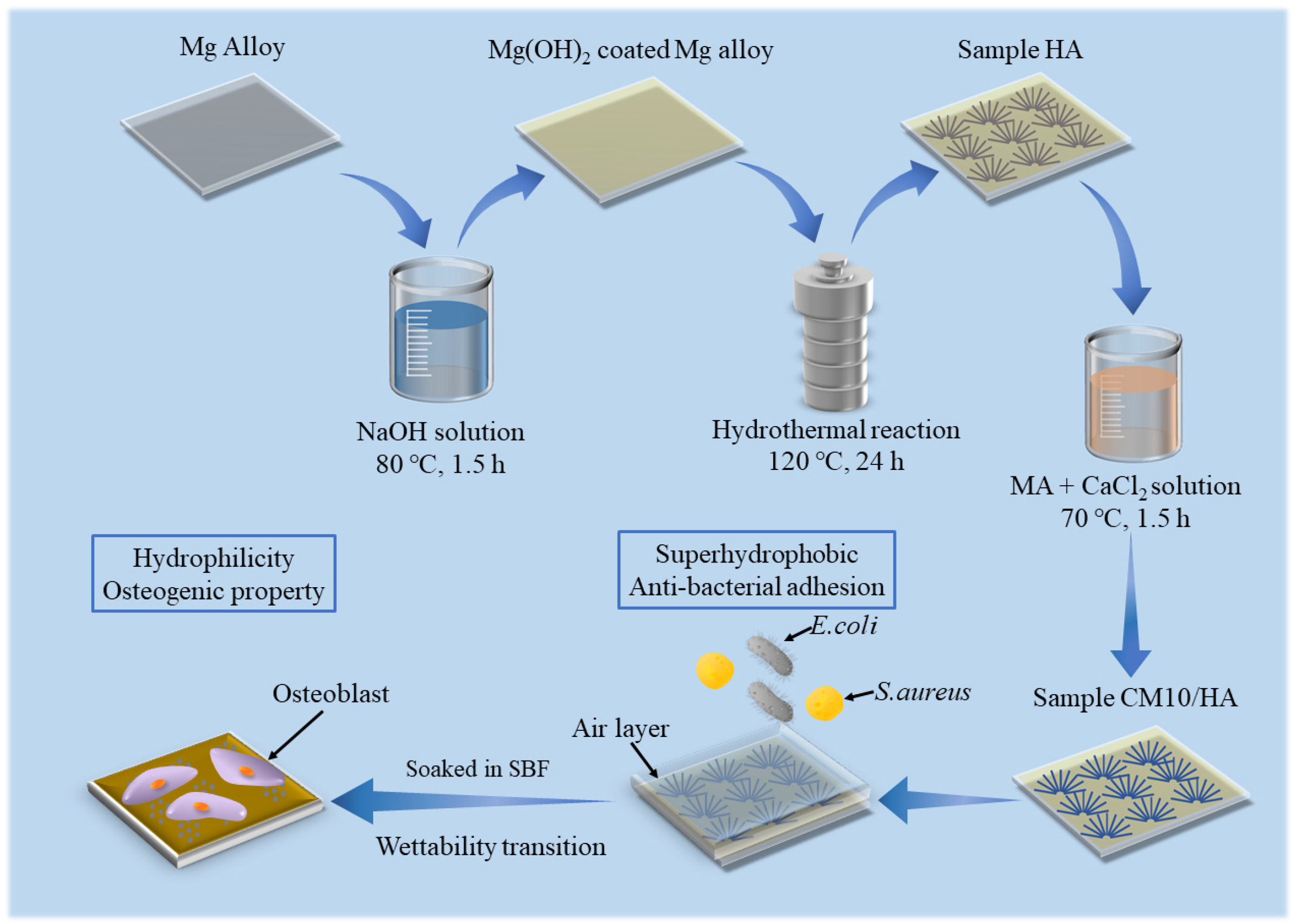

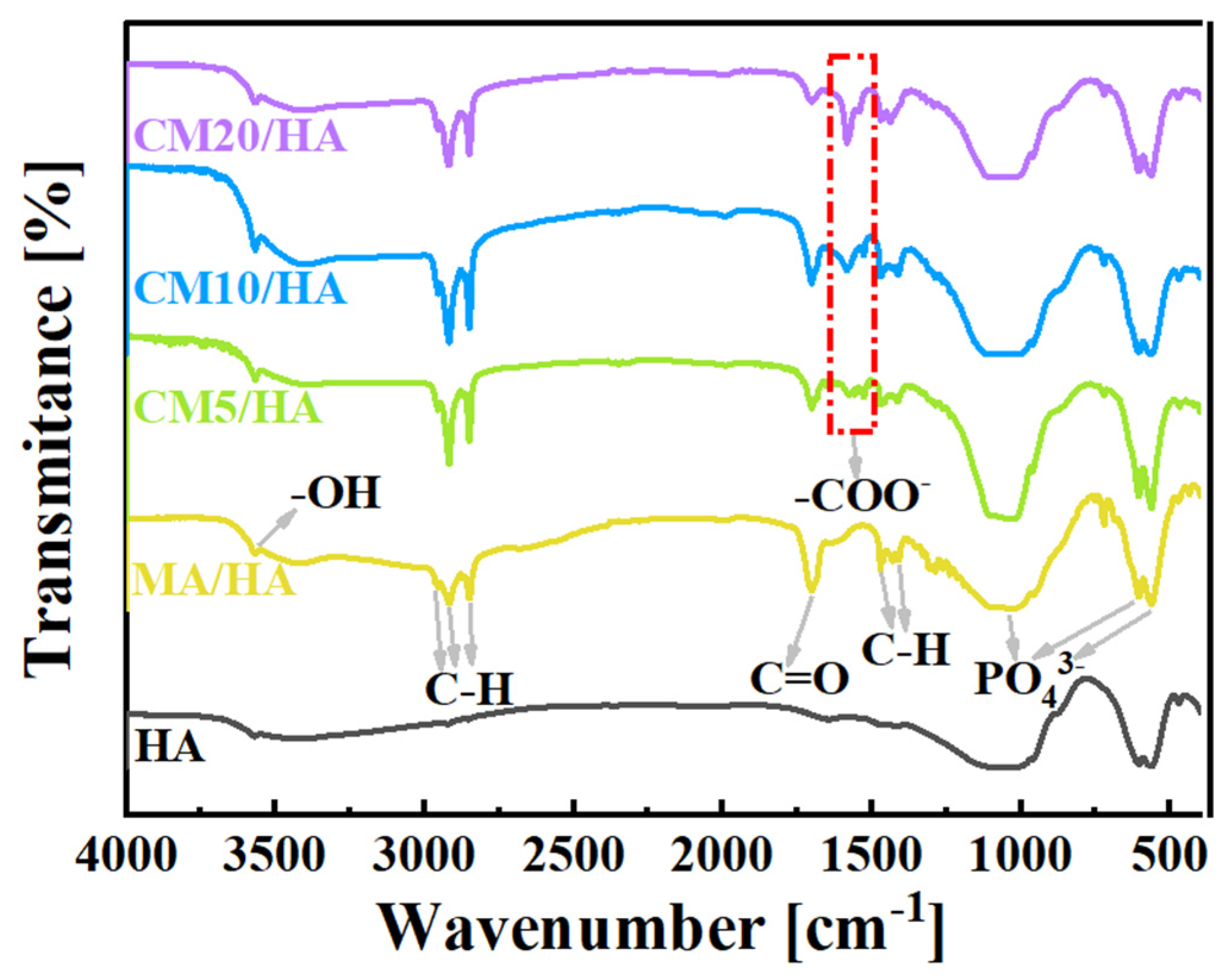

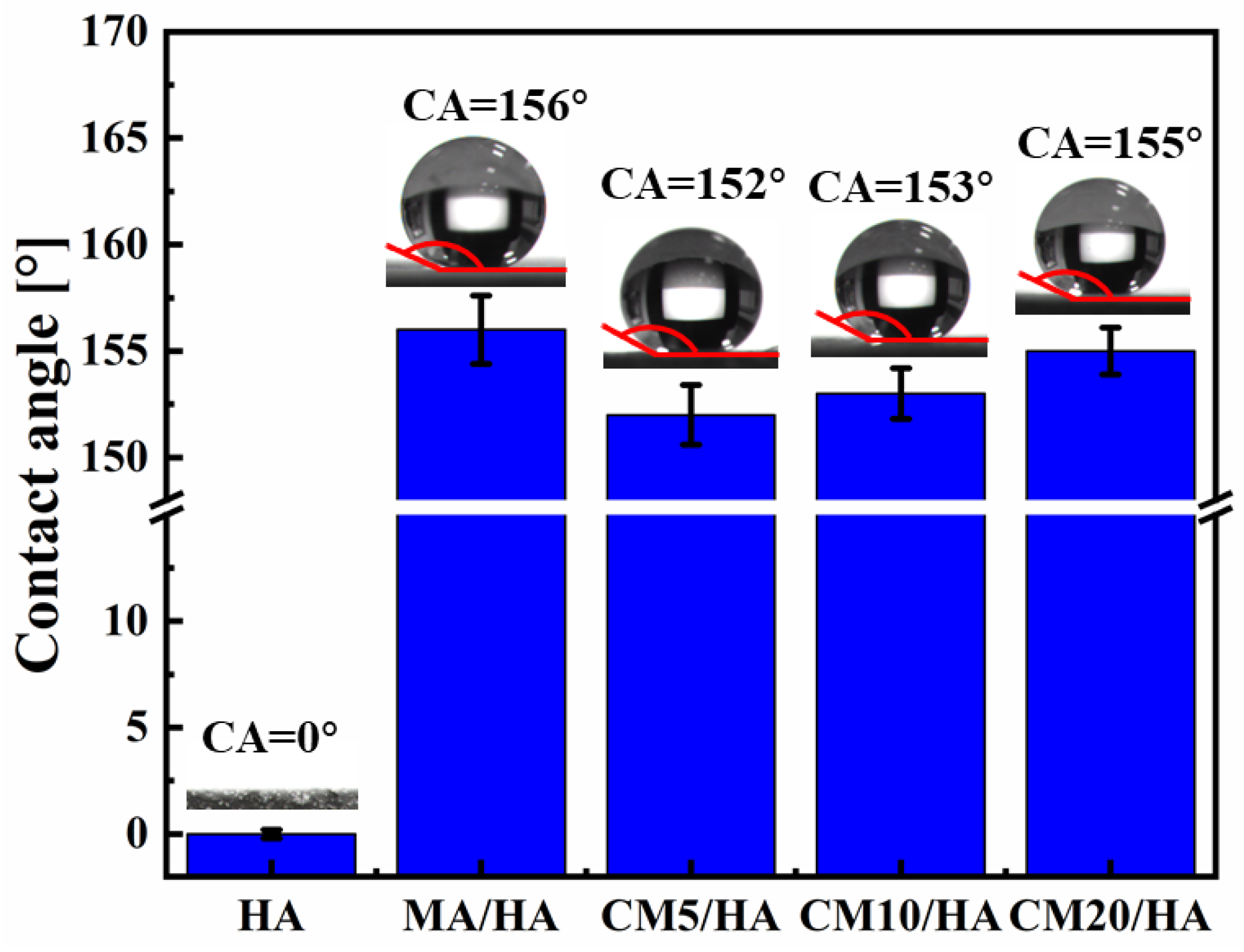
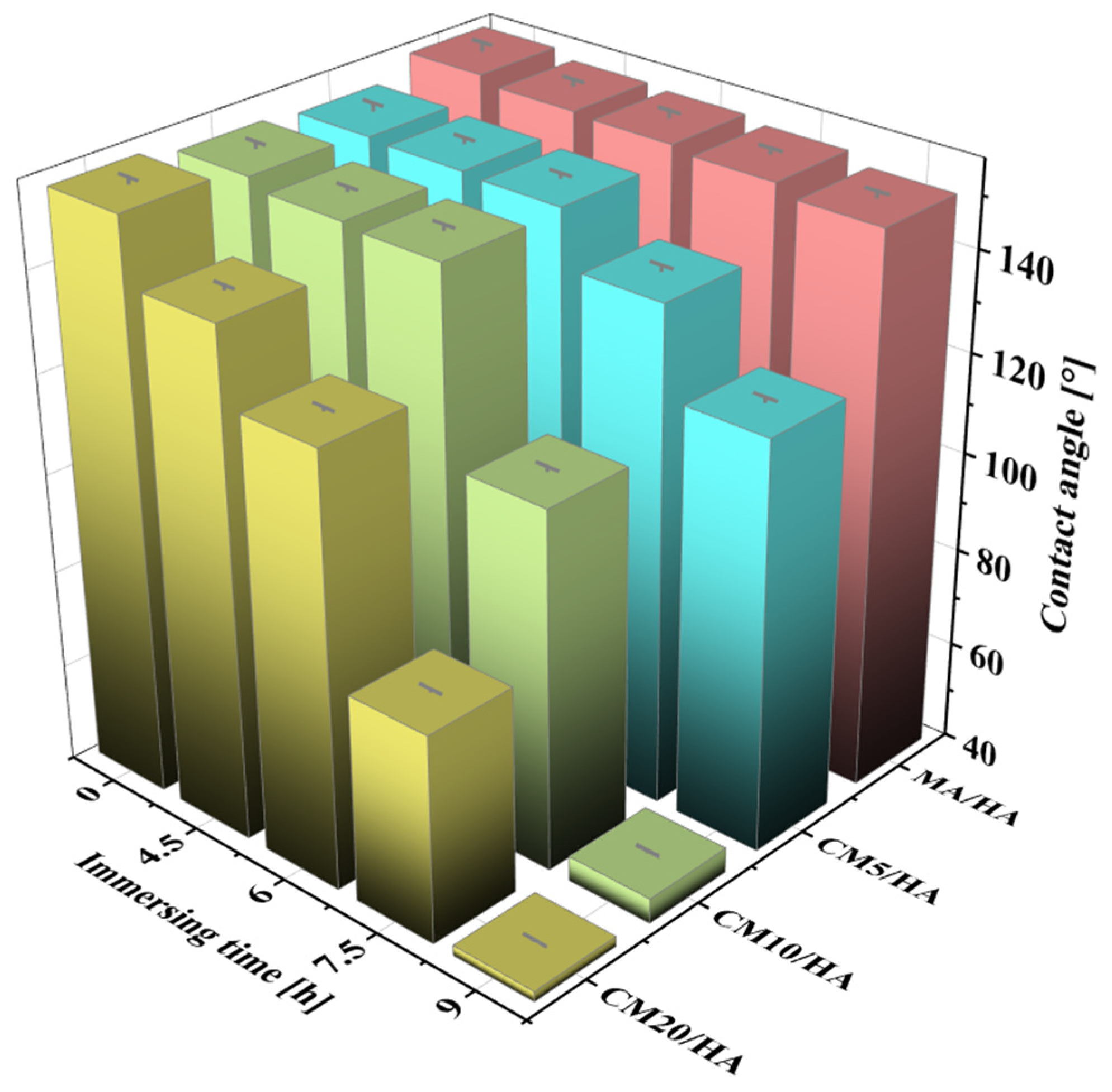
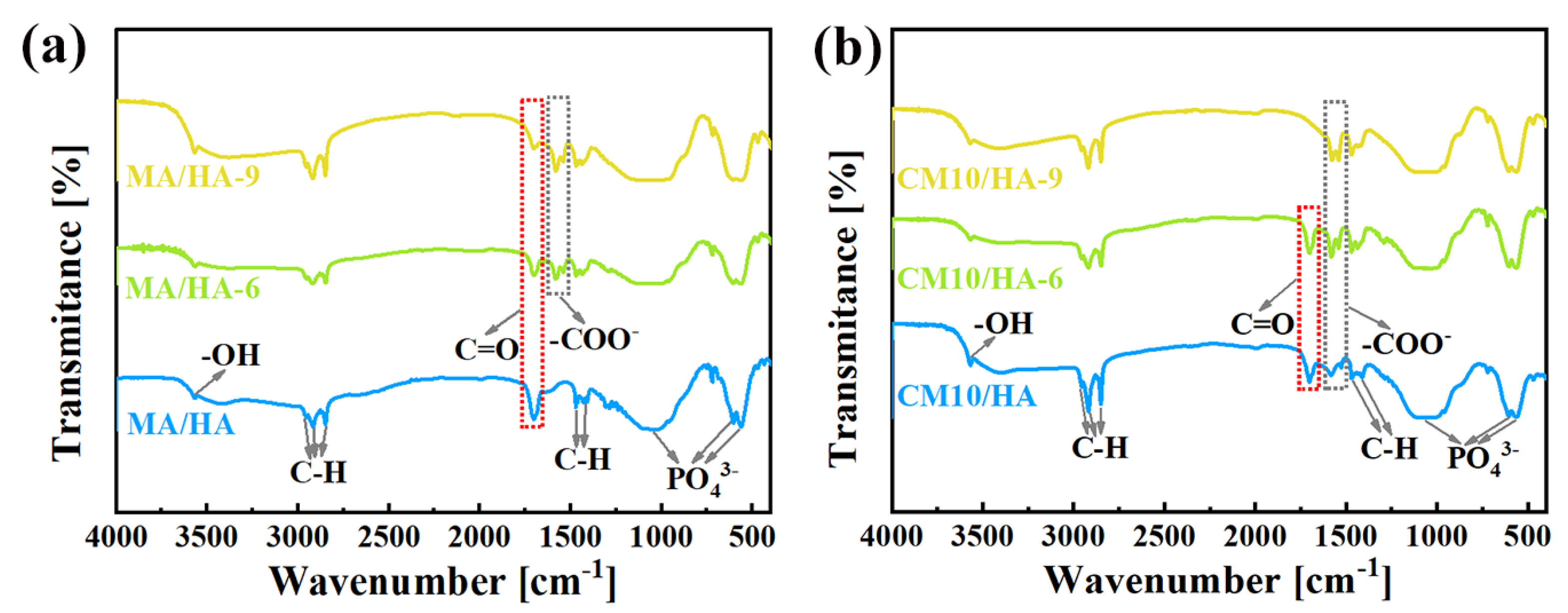
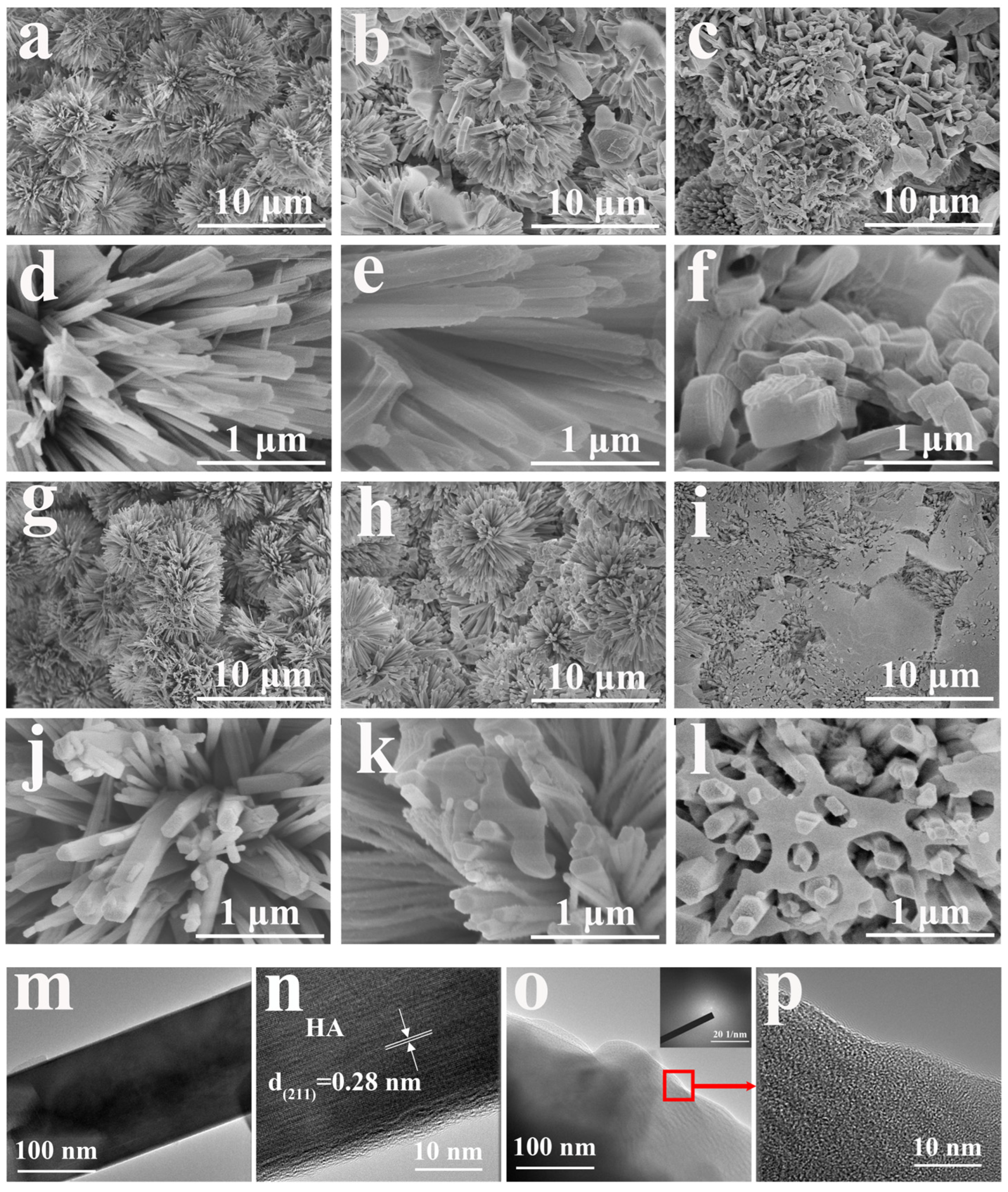
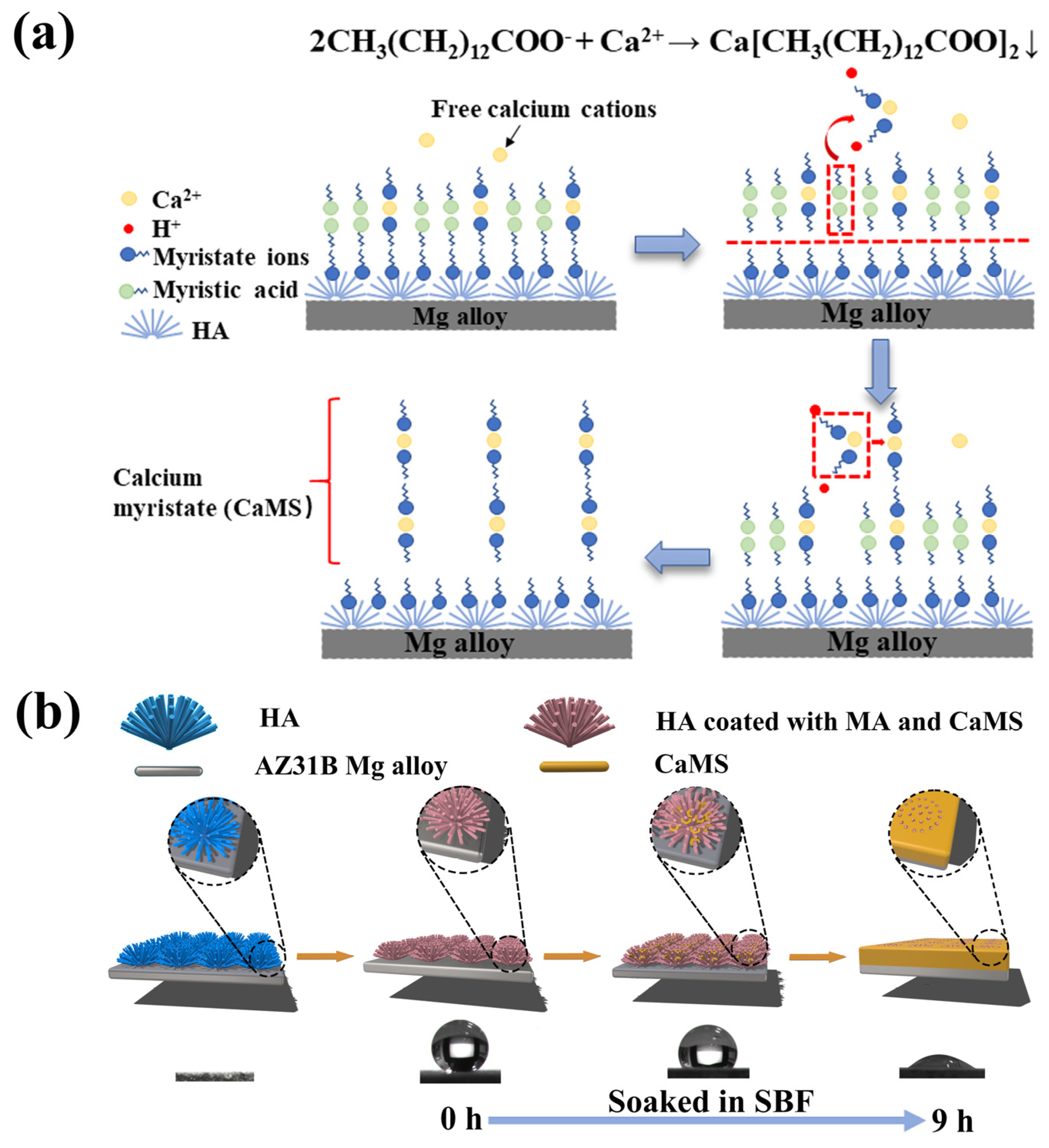
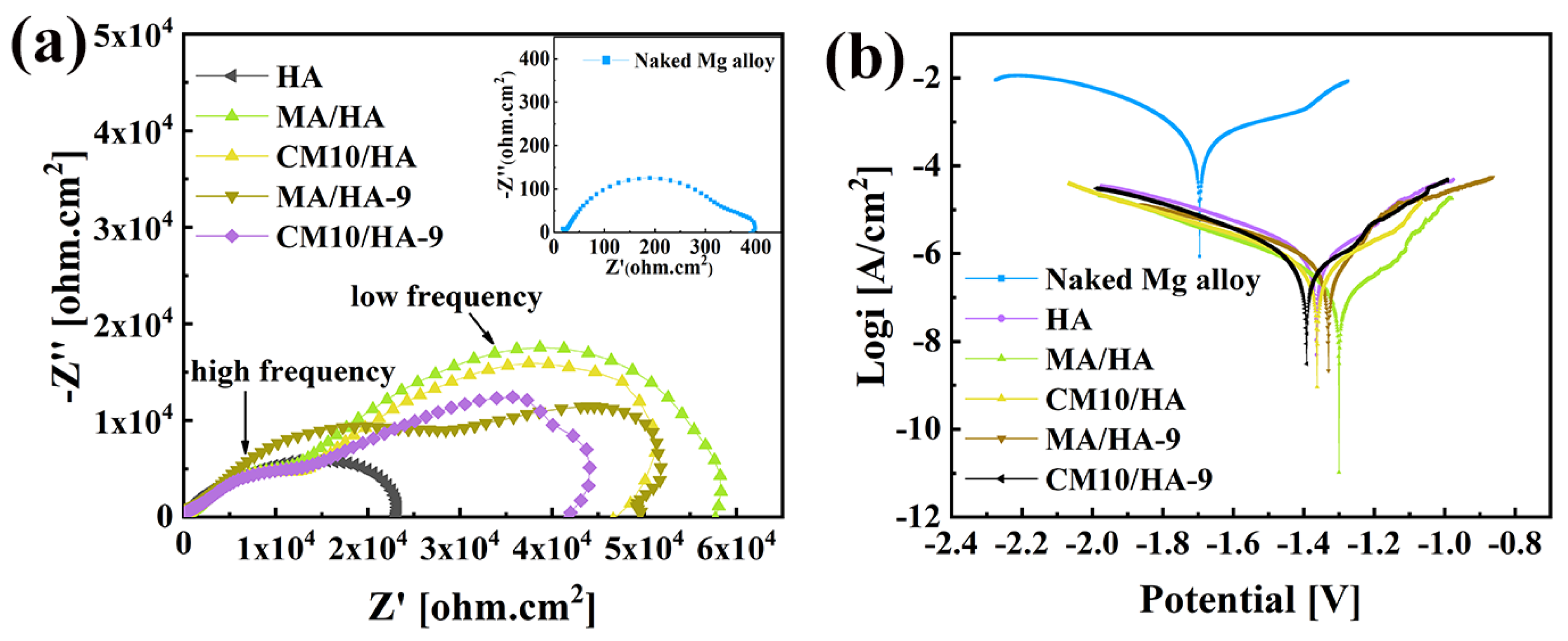
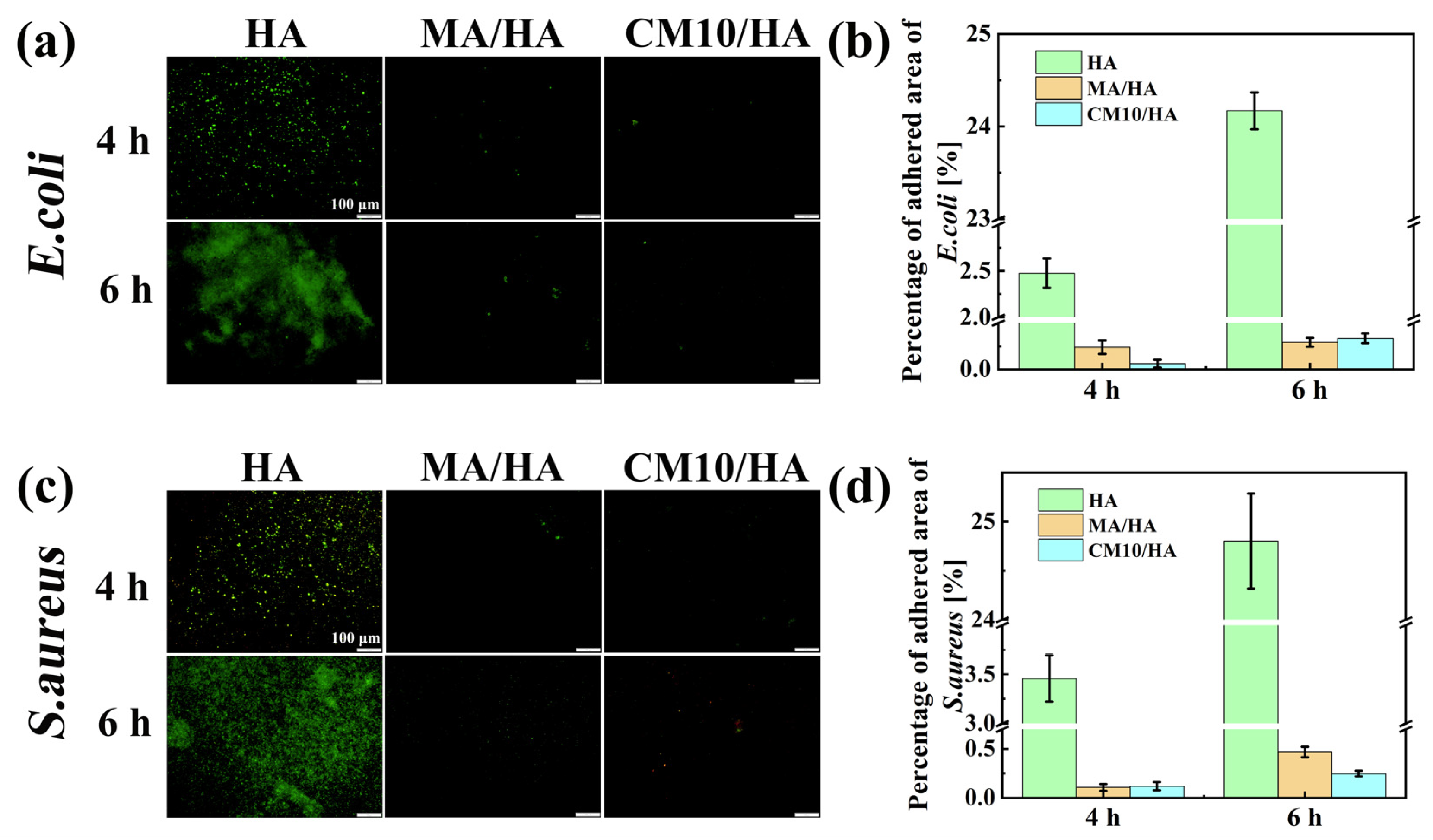


Disclaimer/Publisher’s Note: The statements, opinions and data contained in all publications are solely those of the individual author(s) and contributor(s) and not of MDPI and/or the editor(s). MDPI and/or the editor(s) disclaim responsibility for any injury to people or property resulting from any ideas, methods, instructions or products referred to in the content. |
© 2025 by the authors. Licensee MDPI, Basel, Switzerland. This article is an open access article distributed under the terms and conditions of the Creative Commons Attribution (CC BY) license (https://creativecommons.org/licenses/by/4.0/).
Share and Cite
Yan, S.; Cai, S.; Zuo, Y.; Zhang, H.; Yang, T.; Ling, L.; Zhang, H.; Lu, J.; He, B. Coated Mg Alloy Implants: A Spontaneous Wettability Transition Process with Excellent Antibacterial and Osteogenic Functions. Materials 2025, 18, 1908. https://doi.org/10.3390/ma18091908
Yan S, Cai S, Zuo Y, Zhang H, Yang T, Ling L, Zhang H, Lu J, He B. Coated Mg Alloy Implants: A Spontaneous Wettability Transition Process with Excellent Antibacterial and Osteogenic Functions. Materials. 2025; 18(9):1908. https://doi.org/10.3390/ma18091908
Chicago/Turabian StyleYan, Sijia, Shu Cai, You Zuo, Hang Zhang, Ting Yang, Lei Ling, Huanlin Zhang, Jiaqi Lu, and Baichuan He. 2025. "Coated Mg Alloy Implants: A Spontaneous Wettability Transition Process with Excellent Antibacterial and Osteogenic Functions" Materials 18, no. 9: 1908. https://doi.org/10.3390/ma18091908
APA StyleYan, S., Cai, S., Zuo, Y., Zhang, H., Yang, T., Ling, L., Zhang, H., Lu, J., & He, B. (2025). Coated Mg Alloy Implants: A Spontaneous Wettability Transition Process with Excellent Antibacterial and Osteogenic Functions. Materials, 18(9), 1908. https://doi.org/10.3390/ma18091908




